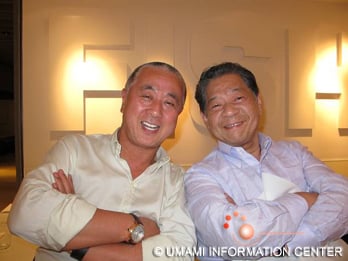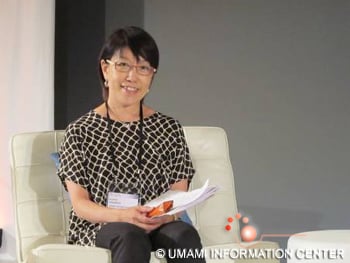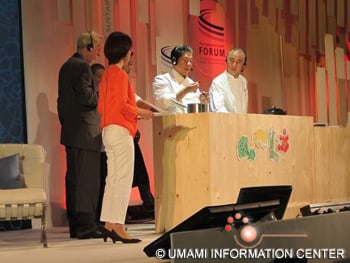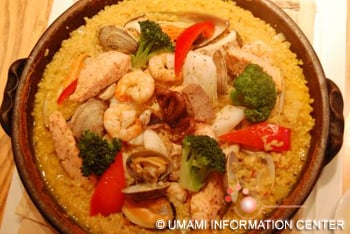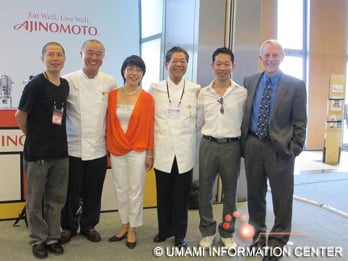"Eat well, Live Well" session in the Global Summit of The Consumer Goods Forum in Barcelona, Spain
July 2011
The Consumer Goods Forum
UIC participated at the Global Summit 2011
Event Flyer:
What is the Consumer Goods Forum (CGF)? The CGF is a global industry network of CEOs and senior managers from over 650 retailers, manufacturers, service providers and other stakeholders across 70 countries. The forum reflects the industrial and geographical diversity of its company members.
The Forum was first created in 2009 under the name of Global Commerce Initiative (GCI) with 50 CEOs from the manufacture and retail industry. It resulted from the merge of CIES, a food and consumer goods industry body, with the Global CEO Forum and the Global Commerce Initiative, two global platforms in the retail and manufacture industry.
The Forum allows the exchanging of knowledge and initiatives on its five strategic priorities, emerging trends, sustainability, safety & health. The actual CGF Vision is, 'Better lives through better business.' This year's global resolution on health & wellness was, to provide products and services that support healthier diets and lifestyles to consumers, transparent fact-based information to help consumers to make informed choices, and educational programs to raise awareness and inspiration of healthier lifestyles.
Chef's Session : "Eat Well, Live Well" (with umami taste)
Health and Diet
We have evolved for millions of years to like tastes such as sweet, fat and salty and ensure enough nutrient uptake, which is an advantage for our survival. Gary Beauchamp, the director of the Monell Chemical Senses Center, says that those foods that provide energy and essential nutrients like sodium were not easy to find during our early existence, so to prefer them was a desirable trait. However, in the past 100 years the trend has reversed. Foods have become cheap and plentiful, so we take too much fat, sugar and salt. Thus, as life expectancy in developed and many developing countries has prolonged, life style diseases related to dietary habits such as obesity, diabetes and hypertension are becoming the major killer diseases of modern days.
The Global Summit 2011 [Barcelona, Spain]
The Umami Information Center (UIC) had one particular ambition at the Global Summit of The Consumers Goods Forum this year, to pair umami taste and healthy eating through the concept of dashi. Umami is an obvious alternative to lower fat and salt in our cooking, and nobody knows how to make dashi better than Chef Yoshihiro Murata from the restaurant Kikunoi in Kyoto. We also invited Chef Nobu Mastuhisa from Nobu restaurants for his vast experience in adapting Japanese cuisine to the taste of other culinary cultures. In a dynamic presentation entitled 'Eat well be well,' the two Japanese chefs accompanied by the director of the Monell Center in Philadelphia Gary Beauchamp and the director of UIC Kumiko Ninomiya explained to the audience that umami is a universal taste and the dashi concept can be transferred to all cuisines. And what is the dashi concept? It is nothing more than a clear soup rich in umami with almost zero calories. Traditionally, dashi has been made in Japan with kombu seaweed and dried bonito.
Health and umami taste
It is easy to say avoid high salt, fat and sugar and control the caloric and salt intake. But nobody likes to sacrifice taste for health. We are wired to eat foods that we like, creamy and full of flavor. And our message is: in fact, we don't have to sacrifice taste for health, because we have umami. Umami taste is pleasant and balances the overall perception of a dish even with a low fat content. The clearest evidence is in the Japanese shokado lunch box. We analyzed a sample of the lunch box from Kikunoi restaurant that was made with 40 different types of ingredients and dashi, and even though the food volume of the lunch box was considerable, the whole contents had only 450 kcal, the same amount of a 120 gram beef stake and probably as or more delicious than the stake.
Chef's Session :New Style Dashi
In front of around 400 CEOs that came to our forty five-minute presentation, in which they learned that umami taste gives a mouthwatering and tongue coating sensation, Chef Murata explained how to prepare a New Style Dashi. Umami substances like the amino acid glutamate and nucleotides inosinate and guanylate are present in many food ingredients, not only in kombu seaweed or dried bonito. So by knowing the umami content of other ingredients, Chef Murata changed kombu seaweed from Japanese dashi as a source of glutamate for Spanish dried tomatoes. And he substituted the source of nucleotides like dried bonito in Japanese dashi for dried morel mushrooms and minced chicken breast. This is how the concept of a typical Japanese dashi was transformed into a western style dashi with flavors that are closer to the western cuisine.
The real transformation came with the final step when Chef Nobu Matsuhisa prepared a paella-like dish using the tomato dashi in brown rice and an assortment of seafood and vegetables. He called this rice 'Arroz con dashi.' Chef Murata also prepared a traditional miso soup with the tomato dashi to demonstrate that tomato and kombu dashi are interchangeable and can adapt to any type of cuisine.
These two iconic chefs revealed that the conscious understanding of umami goes hand by hand not only with innovation, since a new dish was created from an old and well known concept, but also with health given that no oil was used to prepared arroz con dashi and still had a rich taste and aroma.
Interestingly, this kind of light but tasty cooking seems to have a place in first class cuisine as well. Top Chefs like Silvena Rowe, specialized in Middle Eastern Cuisine from the restaurant Quince in London, is after the reduced-fat diet. According to her own words, she would like to be the 'Nobu Turkish cuisine.' And she is after her goal by taking off the oil and adding herbs and fruits. It would be interesting to see her evolution as chef if she were introduced to the dashi concept and umami taste on her pursuit to healthy cooking. Other Chefs are also becoming stricter to taste, going after better quality ingredients by growing their products themselves such as Swedish Chefs Bjorn Frantzen and Daniel Lindeberg. Once more, the conscious knowledge of umami could satisfy these kinds of chefs for who taste is a very important part of the final dish. So it seems that more than ever there is a place for umami in world cuisines. (Wall Street Journal, Friday June 17, 2011)
A New Generation of Chefs
Chef Hideki Matsuhisa, owner in Barcelona of the Japanese restaurant Koy Shunka and Daisuke Hayashi from Sakenohana restaurant in London were the right hand of Chefs Nobu and Murata during the demonstration. Although still young, Chef Hideki has a very wise motto; to use the best Spanish ingredients, fish, mushrooms, vegetables, etc, to cook the best possible Japanese food. And give them at the end a Japanese touch with sauces and dashis for the final flavor. The freshness of the ingredients most likely contributes to a higher content of umami in his cuisine.
Some complain that his cuisine is not authentic Japanese because not all the ingredients he uses are from Japan, but his deep knowledge of Spanish food and his adaptability make him in fact a smart Chef. He knows how to prepare Japanese food to the palate of Spanish clients. And he certainly succeeds. Similarly, Chef Hayashi believes that Japanese food needs to be adapted to the palate of Westerners from his experiences in London. Both chefs understand how important is to adapt to the availability of good quality ingredients from each country.

